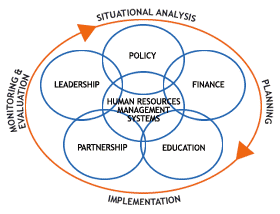
Education
Areas of Intervention
- Pre-service education tied to health needs
- In-service training (e.g., distance and blended, continuing education)
- Capacity of training institutions
- Training of community health workers and non-formal care providers.
Indicators
- Ratio of graduates of pre-service training programs to projected demand by type of health worker
- Attrition of students in pre-service training programs
- Pre-service curricula updated periodically (e.g., within last three years)
- In-service training coordination and evaluation mechanisms in place
- Student/teacher ratios by pre-service institutions and cadres.
Tools and Guidelines
Basic Medical Education: WFME Global Standards for Quality Improvement. World Federation for Medical Education, 2003.
Bridges to Health Worker Employment Overview. CapacityPlus, 2013
Continuing Professional Development (CPD) of Medical Doctors: WFME Global Standards for Quality Improvement. World Federation for Medical Education, 2003.
Continuing Professional Development for Health Workers in Developing Countries. CapacityPlus, 2012
Foundations of Gender Equality in the Health Workforce. CapacityPlus, 2012
Guidelines for Assessing Distance Learning Programmes. International Council of Nurses, 2004.
Health Informatics Education and Training Programs: Important Factors to Consider. CapacityPlus, 2013
HRH Global Resource Center eLearning Platform. CapacityPlus, 2011
Integrating Gender into the Curricula for Health Professionals: Meeting Report. World Health Organization, 2006.
Learning for Performance: A Guide and Toolkit for Health Worker Training and Education Programs. The Capacity Project/CapacityPlus, 2006.
Making It Happen: Using Distance Learning to Improve Reproductive Health Provider Performance. PRIME II, 2002
Postgraduate Medical Education: WFME Global Standards for Quality Improvement. World Federation for Medical Education, 2003.
Pre-Service Education Toolkit. MCHIP, 2011
Preservice Education Family Planning Reference Guide. IntraHealth 2010
Scaling Up Health Worker Production: The Bottlenecks and Best Buys Approach. CapacityPlus, 2013
Strengthening the Health Worker Pipeline through Gender-Transformative Strategies. CapacityPlus, 2012
Supporting Existing Health Cadres in Learning New Skills: Tools and Approaches. The Capacity Project, 2006.
Training and Learning Standards. IntraHealth, October, 2012
Training Toolkit. I-TECH
Training Works! What You Need to Know about Managing, Designing, Delivering and Evaluating Group-Based Training. JHPIEGO, 2003.
WHO/WFME Guidelines for Accreditation of Basic Medical Education World Federation for Medical Education, 2003.
Resources
Building Stronger Human Resources for Health through Licensure, Certification and Accreditation. The Capacity Project, 2006.
Conférence Internationale des Doyens et des Facultés de Médecine d’Expression Française.
Ethiopia’s Human Resources for Health Programme. Global Health Workforce Alliance, World Health Organization, Case study, January 2008
Gender-Based Violence Training Modules: A Collection and Review of Existing Materials for Training Health Workers. The Capacity Project, 2006.
Scaling Up, Saving Lives. Global Health Workforce Alliance, 2008.
Task Shifting for a Strategic Skill Mix. The Capacity Project, 2006.
The Sub-Saharan African Medical School Study, Dec 2010.
Transformative Scale Up of Health Professional Education. WHO, 2011
